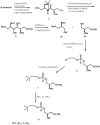Synthesis of lysophospholipids
- PMID: 20335986
- PMCID: PMC6257299
- DOI: 10.3390/molecules15031354
Synthesis of lysophospholipids
Abstract
New synthetic methods for the preparation of biologically active phospholipids and lysophospholipids (LPLs) are very important in solving problems of membrane-chemistry and biochemistry. Traditionally considered just as second-messenger molecules regulating intracellular signalling pathways, LPLs have recently shown to be involved in many physiological and pathological processes such as inflammation, reproduction, angiogenesis, tumorogenesis, atherosclerosis and nervous system regulation. Elucidation of the mechanistic details involved in the enzymological, cell-biological and membrane-biophysical roles of LPLs relies obviously on the availability of structurally diverse compounds. A variety of chemical and enzymatic routes have been reported in the literature for the synthesis of LPLs: the enzymatic transformation of natural glycerophospholipids (GPLs) using regiospecific enzymes such as phospholipases A1 (PLA1), A2 (PLA2) phospholipase D (PLD) and different lipases, the coupling of enzymatic processes with chemical transformations, the complete chemical synthesis of LPLs starting from glycerol or derivatives. In this review, chemo-enzymatic procedures leading to 1- and 2-LPLs will be described.
Figures















Similar articles
-
Selective measurement of NAPE-PLD activity via a PLA1/2-resistant fluorogenic N-acyl-phosphatidylethanolamine analog.J Lipid Res. 2022 Jan;63(1):100156. doi: 10.1016/j.jlr.2021.100156. Epub 2021 Nov 26. J Lipid Res. 2022. PMID: 34843683 Free PMC article.
-
Lysophospholipids and their G protein-coupled receptors in atherosclerosis.Front Biosci (Landmark Ed). 2016 Jan 1;21(1):70-88. doi: 10.2741/4377. Front Biosci (Landmark Ed). 2016. PMID: 26594106 Free PMC article.
-
Lysophospholipids and their G protein-coupled receptors in atherosclerosis.Front Biosci (Landmark Ed). 2016 Jan 1;21(1):70-88. doi: 10.2741/4377. Front Biosci (Landmark Ed). 2016. PMID: 26709762 Review.
-
Current Knowledge on Mammalian Phospholipase A1, Brief History, Structures, Biochemical and Pathophysiological Roles.Molecules. 2022 Apr 12;27(8):2487. doi: 10.3390/molecules27082487. Molecules. 2022. PMID: 35458682 Free PMC article. Review.
-
Use of phospholipase A2 for the production of lysophospholipids.Methods Mol Biol. 2013;1009:63-8. doi: 10.1007/978-1-62703-401-2_7. Methods Mol Biol. 2013. PMID: 23681524
Cited by
-
Metabolomics shows the Australian dingo has a unique plasma profile.Sci Rep. 2021 Mar 4;11(1):5245. doi: 10.1038/s41598-021-84411-6. Sci Rep. 2021. PMID: 33664285 Free PMC article.
-
A sustainable and regioselective synthesis of Hemi-bis(monoacylglycero)phosphates and bis(diacylglycero)phosphates.iScience. 2023 Jun 9;26(7):107075. doi: 10.1016/j.isci.2023.107075. eCollection 2023 Jul 21. iScience. 2023. PMID: 37448559 Free PMC article.
-
Impact of Sulfur Fumigation on the Chemistry of Dioscoreae Rhizoma (Chinese Yam).ACS Omega. 2023 May 30;8(23):21293-21304. doi: 10.1021/acsomega.3c02729. eCollection 2023 Jun 13. ACS Omega. 2023. PMID: 37332814 Free PMC article.
-
Expression of secreted phospholipase A2-Group IIA correlates with prognosis of gastric adenocarcinoma.Oncol Lett. 2015 Nov;10(5):3050-3058. doi: 10.3892/ol.2015.3736. Epub 2015 Sep 21. Oncol Lett. 2015. PMID: 26722288 Free PMC article.
-
Novel Lipid-Based Carriers of Provitamin D3: Synthesis and Spectroscopic Characterization of Acylglycerol Conjugated with 7-Dehydrocholesterol Residue and Its Glycerophospholipid Analogue.Molecules. 2024 Dec 9;29(23):5805. doi: 10.3390/molecules29235805. Molecules. 2024. PMID: 39683962 Free PMC article.
References
-
- Vance D.E., Vance J.E. Biochemistry of Lipids, Lipoproteins and membranes. 4th ed. Elsevier Science; Amsterdam, The Netherlands: 2002. pp. 315–340.
-
- Dowhan W. The role of phospholipids in cell function. Adv. Lipobiol. 1997;2:79–107. doi: 10.1016/S1874-5245(97)80006-7. - DOI
-
- Barenholz Y., Cevc G. Structure and Properties of Membranes. In: Baskin A., Norde W., editors. Physical Chemistry of Biological Interfaces. Marcel Dekker; New York, NY, USA: 2000. pp. 171–242.
-
- Goetzl E.J., An S. Diversity of cellular receptors and functions for the lysophospholipid growth factors lysophosphatidic acid and sphingosine 1-phosphate. FASEB J. 1998;12:1589–1598. - PubMed
Publication types
MeSH terms
Substances
LinkOut - more resources
Full Text Sources
Other Literature Sources

